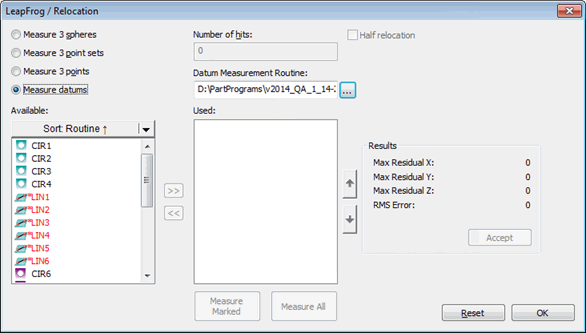
PC-DMIS does not support Leapfrog and Bundle Alignment commands used in the same measurement routine.
Select Insert | Alignment | Leapfrog to display the LeapFrog / Relocation dialog box. This menu option is disabled in Offline mode. You must be connected to a physical and supported portable machine.

LeapFrog / Relocation dialog box
The LeapFrog / Relocation dialog box allows you to move supported portable machines in order to measure parts that are too large for your CMM. You should be aware of machine accuracy limitations before using this method.
The basis for Leapfrog is to measure a series of features, and then after moving the machine, re-measure the same features in the same order. This creates a transformation and makes the machine behave as if it were in the same coordinate system before the move.
Prior to PC-DMIS version 4.2, Leapfrog transformation information was stored in a separate file and was thereby independent of all measurement routines. This meant the Leapfrog was still active in newly-created measurement routines and you had to remove it by clicking the Reset button on the Leapfrog / Relocation dialog box. In version 4.2 and later, however, this has changed. Leapfrog transformation information is now stored with the measurement routine that used the Leapfrog operation; you no longer have to remove the Leapfrog from new measurement routines.
PC-DMIS enters a Leapfrog command into the Edit window when you click the Accept button.
The command line in the Edit
window is:
LEAPFROG/TOG1, NUM, TOG2
TOG1: This first parameter in the Leapfrog command is a toggle field that relates to the different types of measurement options that are available in the dialog box. These include:
SPHERES (Measure 3 Spheres option)
PSETS (Measure 3 Point Sets option)
POINTS (Measure 3 Points option)
DATUMS (Measure Datums option)
There is also an OFF value for this parameter, in which case the other two parameters do not appear. The OFF value turns off Leapfrog translation.
NUM: This second parameter in the Leapfrog command is the number of hits you want to take. This corresponds to the Hits box in the LeapFrog / Relocation dialog box.
TOG2: This last parameter in the Leapfrog command is a toggle field that you can use to switch between either a FULL or a PARTIAL Leapfrog. This parameter corresponds to the Half relocation option in the dialog box.
When this command executes, PC-DMIS prompts you to take your hits. After all the hits are taken, a Leapfrog translation is in effect.
More: